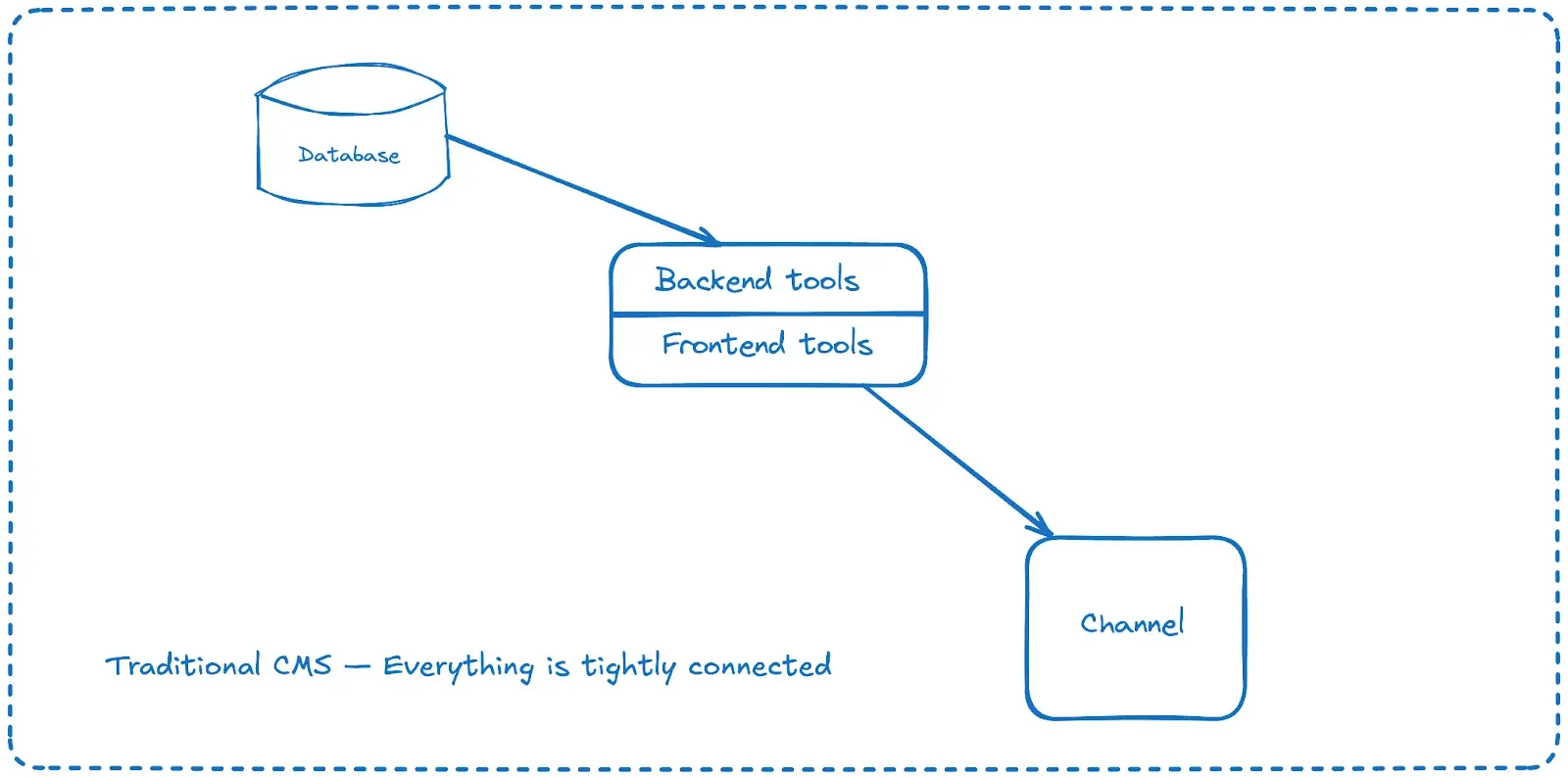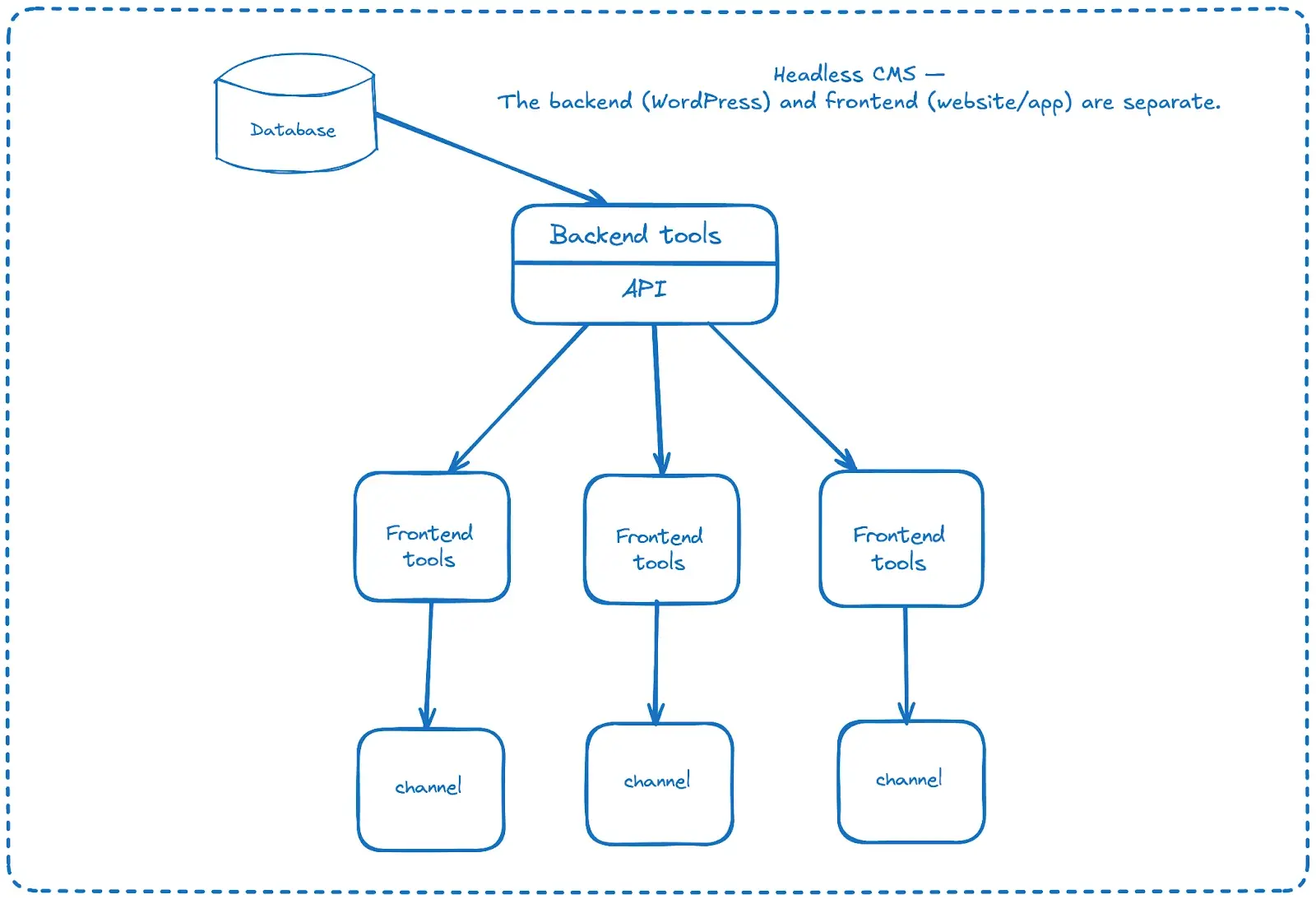WordPress has been around for years, powering everything from small personal blogs to massive business websites.
It’s popular because it’s easy to use, flexible, and comes with thousands of themes and plugins to customize your site.
However, as websites and apps became more complex, developers started looking for better ways to build them. That’s where headless WordPress comes in. Unlike traditional WordPress, which controls both the content and how it’s displayed, Headless WordPress only handles the content. Its look and function are completely separate, built using modern technologies like React, Vue, or Next.js.
So, which one is better? That depends on what you’re building. If you need something simple, like a blog or a small business site, traditional WordPress is probably the way to go. If you’re creating a fast, scalable web app or need your content to work across multiple platforms (like a website and a mobile app), headless WordPress might be the better choice.
In this article, we’ll explain how both options work, their pros and cons, and how to decide which one best fits your project.
Understanding Traditional WordPress
When people think of WordPress, they usually picture the classic setup: a dashboard where you can write and manage content, a theme that controls how everything looks, and plugins that add extra functionality.
This is the traditional WordPress experience, where everything is bundled together in one system. It works well for many websites because it gives you everything you need: a content management system (CMS) and a way to display that content to users.

It’s why so many businesses, bloggers, and even e-commerce stores rely on it. Here’s why many websites still prefer this setup:
User-Friendly: No coding is required. You can install a theme, add plugins, and manage content without touching a line of code.
All-in-One Solution: The backend (content management) and front end (design/display) are handled in the same system.
SEO-Friendly: WordPress offers built-in SEO features like clean URLs, metadata fields, and structured content.
Extensive Plugin Library: Thousands of plugins allow you to add features like contact forms, e-commerce, and security tools.
Large Support Community: Because WordPress is widely used, solutions to common issues are easy to find.
This setup is simple, efficient, and cost-effective for small to medium-sized businesses, blogs, and even e-commerce stores.
But that convenience comes with trade-offs. Here are some areas where traditional [WordPress}(https://verpex.com/blog/wordpress-hosting/wordpress-shortcode-tutorial) struggles:
Performance Bottlenecks: Every time a user visits a page, WordPress has to fetch content from a database, run PHP scripts, and then generate the page on the fly. This process slows down sites with high traffic unless caching is used (which only helps up to a point).
Flexibility Limitations: WordPress themes and page builders allow customization, but you're still working within a predefined structure. If you need a fully custom frontend experience — like a React or Vue-powered web app — you’ll struggle with WordPress’s built-in system.
Security Risks: Because WordPress is so widely used, it’s a major target for hackers. Since the frontend and backend are part of the same system, a security flaw in any part—whether it’s a theme, a plugin, or the core WordPress installation—can expose the entire site.
Scalability Issues: WordPress runs fine for small sites. But if you're handling millions of visitors per month, performance optimizations become essential. Without careful server tuning, CDN caching, and database optimization, WordPress can slow down under heavy load.
Understanding Headless WordPress
Unlike Traditional WordPress, where the backend and frontend are tightly linked, Headless WordPress decouples them. WordPress still acts as the CMS, but it no longer controls how the content is displayed. Instead, it serves content through APIs (REST API or GraphQL), allowing developers to build the frontend using any technology they want — React, Vue, Next.js, and even mobile apps.

This approach is great because it removes WordPress’s built-in design limitations. Developers are no longer tied to PHP-based themes or WordPress’s templating system. Instead, they can create lightweight, fast, and highly customized frontends that load instantly, scale efficiently, and integrate seamlessly with other services.
Take a site like a news platform that wants to deliver content across multiple platforms — a website and a mobile app. With Traditional WordPress, this would require heavy customization, but with Headless WordPress, the CMS acts as a central hub, and each platform simply fetches content through an API.
However, while Headless WordPress solves some problems, it also creates new challenges. This means it’s not for everybody. Here are some downsides to consider before going headless:
More Complex Development: Unlike Traditional WordPress, where a theme and plugins handle most of the work, Headless WordPress requires a custom-built frontend. You need developers skilled in JavaScript frameworks like React or Vue to build and maintain it.
Loss of WordPress Features: Going headless means you lose many built-in WordPress features like themes, widgets, and drag-and-drop page builders. If your team relies on tools like Elementor or Gutenberg, they won’t work in a headless setup.
SEO Requires Extra Effort: Traditional WordPress has built-in SEO optimizations like meta tags, sitemaps, and schema markup. In a headless setup, these need to be manually implemented in the frontend, which requires additional development.
Higher Costs & Maintenance: Instead of running just one system (WordPress), you now have two — a WordPress backend and a separate frontend. Hosting costs may increase since you need a server for WordPress and another for the frontend application. Also, regular updates and maintenance will now require more developer involvement than a traditional WordPress setup.
Key Differences Between Traditional and Headless WordPress
Although we’ve explored the strengths and weaknesses of both Traditional and Headless WordPress, it can still be tricky to decide which one is the right fit for your project.
To make things clearer, here’s a side-by-side comparison of the key differences between the two.
| Feature | Traditional WordPress | Headless WordPress |
|---|---|---|
| Architecture | Monolithic – Backend and frontend are tightly connected. | Decoupled – WordPress is only the backend, and the frontend is built separately. |
| Ease of Use | Beginner-friendly, no coding required. Themes and plugins handle most functionality. | Requires developer expertise to build and maintain a custom frontend. |
| Performance | Can be slow, especially with too many plugins or dynamic content. Requires caching. | Generally faster, especially with static site generation (SSG) using frameworks like Next.js. |
| Flexibility | Limited to WordPress’s theme and plugin ecosystem. Customization requires PHP. | Highly flexible—developers can use modern frameworks (React, Vue, etc.) to build custom experiences. |
| SEO | Built-in SEO-friendly features, with plugins like Yoast SEO enhancing optimization. | Requires manual implementation of SEO best practices in the frontend framework. |
| Security | More vulnerable due to themes, plugins, and direct exposure to the web. | More secure by default—WordPress is only used as a backend, reducing the attack surface. |
| Cost & Maintenance | More affordable and easier to manage for non-technical users. | Higher costs—requires separate hosting for frontend and backend, plus ongoing developer maintenance. |
When to Choose Traditional WordPress
Traditional WordPress is best for projects where simplicity, cost-effectiveness, and ease of management matter more than advanced customization and performance optimization.
If you need to set up a website quickly without hiring a developer, this is the way to go.
1. Personal Blogs, Small Business Websites, and Marketing Sites
If your main goal is to publish content, attract visitors, and maybe convert them into customers, Traditional WordPress is a great choice. It comes with built-in blogging tools, SEO-friendly features, and thousands of themes that make launching a website easy.
For personal bloggers or small business owners, this means you can focus on your content or business rather than worrying about technical complexities.
2. When Ease of Use and Quick Setup Are Priorities
Not everyone has the time (or skills) to build a custom-coded frontend. With Traditional WordPress, you can pick a theme, install some plugins, and have a functional website in a matter of hours.
Even non-technical users can update content, tweak layouts with page builders, and manage their sites without needing a developer.
3. Sites That Depend on Plugin-Based Functionalities (e.g., WooCommerce)
Many WordPress plugins, including WooCommerce, are designed to work best with Traditional WordPress. If you’re building an online store and want to use WooCommerce, going headless could introduce unnecessary complexity.
Traditional WordPress allows you to install plugins for payment processing, shipping, and inventory management without any custom API integrations.
4. Budget-Conscious Projects with Minimal Development Resources
If you’re working with a tight budget, Traditional WordPress is the more cost-effective option. You don’t need to hire a developer to build and maintain a separate frontend, and hosting costs are lower since everything runs on a single system.
While scaling up might require additional optimizations, for most small to medium-sized websites, this setup is more than enough.
When to Choose Headless WordPress
While Traditional WordPress is great for standard websites, it starts to show limitations when dealing with performance-heavy applications, large-scale projects, or multi-platform content delivery.
If flexibility, security, and scalability are top priorities, Headless WordPress might be the better choice.
1. Large-Scale, High-Traffic Websites Needing Performance Optimization
If your website serves millions of visitors per month, Traditional WordPress may not scale well. A headless setup allows you to use a static site generator (SSG) or server-side rendering (SSR) to deliver content faster. Since the frontend is decoupled from WordPress, you can optimize load times and prevent slow database queries from affecting the user experience.
For example, a news platform or media site with viral content can benefit from a static frontend that loads instantly while still pulling fresh content from WordPress’s backend.
2. Web Applications Requiring Custom Frontend Frameworks
Traditional WordPress is theme-dependent, meaning you must work within its templating system. But if you're building a modern web application with dynamic content, real-time interactions, or advanced UI components, you'll likely need React, Vue, or another JavaScript framework—which works best in a headless setup.
For instance, a SaaS platform that provides a dashboard for users wouldn’t be a good fit for Traditional WordPress, but Headless WordPress allows you to store content in WordPress while having complete control over how it's presented.
3. Multi-Platform Content Delivery (Websites, Mobile Apps, IoT)
If you need to serve content across multiple platforms (a website, a mobile app, and even an IoT device), Headless WordPress is a better option. The API-first approach lets you manage content in one place while distributing it to different devices.
A good example is a company that publishes news articles across its website, mobile app, and even smart assistants (like Alexa or Google Assistant). A headless setup ensures that the same content is delivered across all platforms consistently.
4. Businesses That Prioritize Security and Scalability
Headless WordPress provides an extra layer of security since WordPress is not directly exposed to the web. This makes it less vulnerable to attacks like DDoS, brute force logins, and SQL injections.
For companies handling sensitive data, enterprise clients, or government sites, security is a top concern. A headless approach reduces attack vectors, making it a smarter choice for businesses with strict security policies.
What’s Next?
So, which one should you choose—Traditional WordPress or Headless WordPress?
It comes down to your project’s goals, budget, and technical requirements.
- If you need a simple, cost-effective website that’s easy to manage, Traditional WordPress is the best choice.
- If you’re building a highly scalable, performance-optimized web application that needs flexibility, Headless WordPress is worth considering.
- If you’re unsure, start with Traditional WordPress—you can always go headless later if your needs evolve.
The web is constantly changing, and the way we build websites is evolving too. While Headless WordPress offers incredible flexibility, it’s not always necessary.
Carefully evaluate your project’s requirements and choose the approach that best suits your team, budget, and long-term vision.
Frequently Asked Questions
Are WordPress-free themes safe?
People often think that free themes have low quality. However, free WordPress themes actually have high quality and are free to use.
What is managed hosting for WordPress?
Managed Hosting for WordPress means that the hosting providers handle the management, administration, and support of the infrastructure of your WordPress website. You can read more about Managed Hosting for WordPress on our blog.
Do more plugins slow down WordPress?
Yes, more plugins can slow down WordPress, especially if they are poorly coded, resource-intensive, or conflict with each other. It's important to use only essential, well-optimized plugins to maintain site performance.
Is managed hosting for WordPress worth it?
You want to make sure that your WordPress website is in the best hands, runs efficiently, and is secure. When you take into consideration all of the benefits that managed hosting for WordPress has, it is definitely worth the investment.
What is the difference between hosting for WordPress and WooCommerce hosting?
Hosting for WordPress is optimized for general WordPress sites, focusing on speed, security, and updates.
WooCommerce hosting on the other hand is specifically designed for online stores, offering additional features like enhanced performance for eCommerce, pre-installed WooCommerce, and tools for managing products and payments.

Joel Olawanle is a Software Engineer and Technical Writer with over three years of experience helping companies communicate their products effectively through technical articles.
View all posts by Joel Olawanle





















